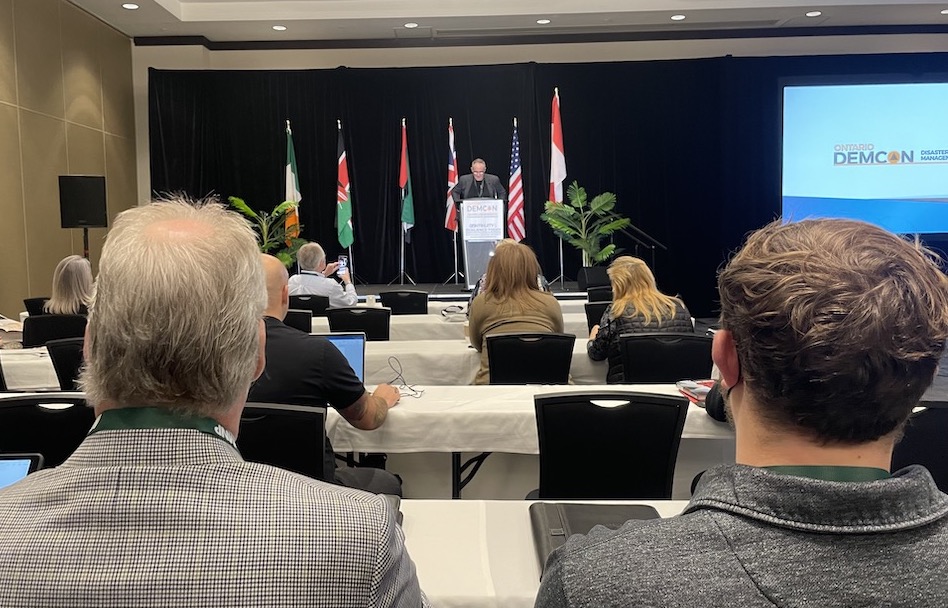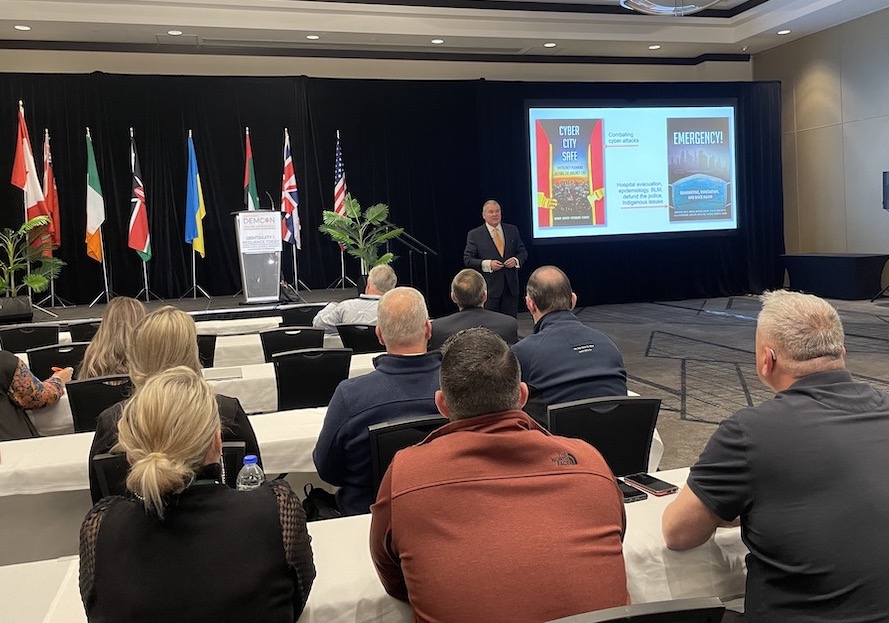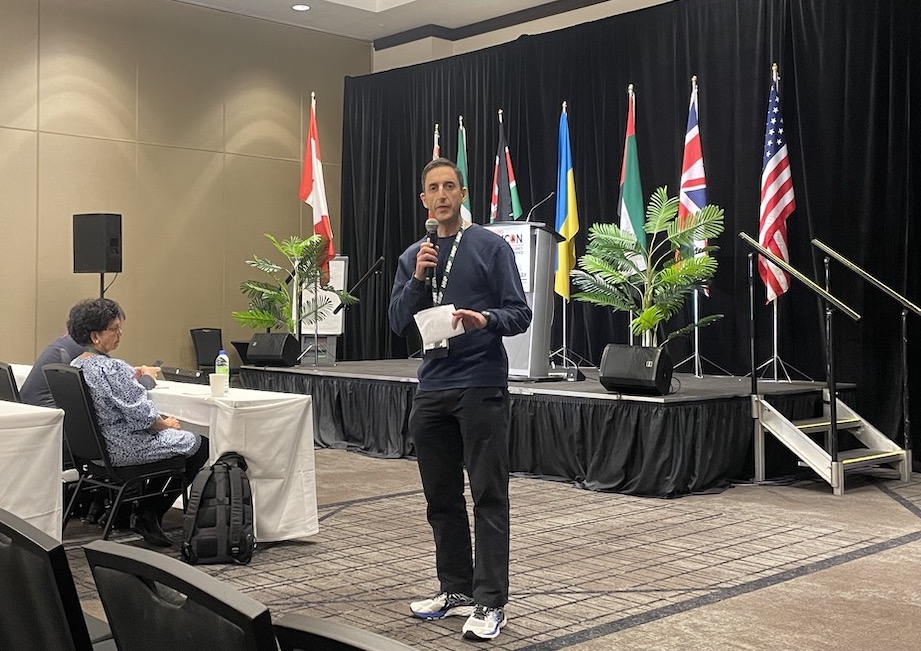
DEMCON speakers challenge emergency managers to rethink processes
November 21, 2022
By
Maria Church
Presentations addressed disaster communication, vulnerabilities, burnout, and the elephant in the room: the pandemic response.
 Kevin Newman opens DEMCON 2022 on Nov. 16 with a keynote on lessons from past disasters. Photo: Annex Business Media.
Kevin Newman opens DEMCON 2022 on Nov. 16 with a keynote on lessons from past disasters. Photo: Annex Business Media. A range of speakers took to the Ontario Disaster and Emergency Management Conference (DEMCON) stage in Toronto last week to talk best practices for emergency managers, and many didn’t shy away from the tough questions.
Opening keynote journalist Kevin Newman set the tone for two days of sessions, beginning with a disclaimer: “It’s not my place to answer these questions, I [as a journalist] get to just ask them.”
Much of Newman’s questions focused on the Covid-19 response and disaster communication. During the early days of the pandemic response, nearly every media outlet shut down its offices. Basic covid facts were channelled to journalists working from home through political agencies rather than emergency planners or health professionals, which resulted in little to no information for media to share, he said. “People will go looking for their own information when they’re scared,” Newman cautioned.
“How do you feel about being largely sidelined in the Covid response? And how do you plan to deal with that? Should you be at the table in the future?” Newman asked the audience.
Newman offered some advice when it comes to communication with the public: It’s a noisy world out there. Mainstream media isn’t your best or most creative way to get your message out, he said, cellphones are. Younger generations are accustomed to crowdsourcing for their news, which means they are sharing and resharing potentially important information during a disaster.
Media and comms teams should be at the beginning of the response process, crowdsourcing information to understand the scope of the situation, Newman suggested, rather than at the end of the process to tell the public what the plan is. “The process should be inverted,” he said.
Ditching the jargon?
The second keynote of the day seemed to continue Newman’s unstated mission of asking uncomfortable questions. Author and disaster management consultant Allan Bonner put municipal emergency managers in the hot seat.

Allan Bonner shares his takeaways from analyzing 100 emergency plans across North America. Photo: Annex Business Media.
For his book Safer Cities of the Future, Bonner read 100 emergency plans for cities across Canada and the U.S. He presented examples in those plans that, in his view, were bogged down with jargon, “essay padding” and “fantasy” situations.
“Why do you have to define what a police chief is?” Bonner asked the crowd, as an example. Other examples included acronyms with no explanation, unrealistic expectations for how the public would act during an emergency, and extraneous details of non-existent hazards.
Bonner also took issue with the “pages and pages, sometimes hundreds of pages” of officials named who contributed to the emergency plan, many of whom were no longer with the municipality.
The good news, he said, is that there are plenty of examples of emergency plans that are effective, both at communicating the plan and understanding the reality of what would happen during a disaster.
Responding to a question from the audience about why so many emergency plans are not up to scratch, Bonner suggested the emergency manager occupation is relatively new and lacking standardization.
Powerful choices
Day 2 keynote, professor Ilan Kelman, offered a jargon-free, seven-word definition of a disaster that he suggested will help emergency managers think about vulnerabilities irrespective of the hazards. A disaster is “a situation requiring outside help for coping.”
The author of Disaster by Choice said it takes time and many choices to create vulnerabilities. It’s the vulnerability that creates the disaster, not the hazard, he said.

Author and professor Ilan Kelman has a simple definition of a disaster: a situation requiring outside help for coping. Photo: Annex Business Media.
As an example, Haiti’s 2010 earthquake was nearly 100 times less powerful than the earthquake that hit Japan in 2011. Yet while Japan’s skyscrapers, designed to withstand seismic activity, were unharmed, Haitian infrastructure crumbled and killed thousands in less than a minute. The Haitian disaster, Kelman said, was centuries in the making – a result of geopolitical decisions that bankrupted the country, making mitigation efforts impossible.
Kelman urged the audience to think about “no disaster by choice,” focussing on efforts to identify and overcome vulnerabilities in their jurisdictions.
In response to a question about how to address the most vulnerable in a population such as those who are elderly, infirm or disabled, Kelman motioned to the conference room. “Who is not here?” he said, “Let’s go ask them.”
Beating burnout
Ian Foss, a director with Emergency Management BC (EMBC), got candid for his session on the impacts of stress, delivered virtually from his home in B.C. The former director of search and rescue survived a stress-related heart attack last year when he was 49 years old.
“My problem is that I want to do more, I want to help. I’m not supposed to, but I want to. And I think some in the audience can relate,” he said.
Now the director of cultural safety for EMBC, Foss emphasized the importance of identifying stress and acknowledging its potential harm. “Undiagnosed, chronic stress can cause havoc on our mental, physical and emotional well-being, which can lead to an illness,” he said.
Foss shared the many ways he has focused on his health, and the health of those around him, since his close call. They include taking stock of his need for physical and mental rest, saying no, making time for exercise, sharing his experience, and reframing how he thinks of his wellness: as life or death decisions.
He concluded with a cautionary quote: “If you don’t make time for your wellness, you will be forced to make time for your illness.”
A taste of Avert
We introduced our teaser issue at the conference. Check out the digital edition here and reach out with feedback or ideas! mchurch@annexbusinessmedia.com.
Correction: An earlier version of this article incorrectly stated the Haiti earthquake was 1,000 times less powerful than the 2011 earthquake in Japan.
Print this page